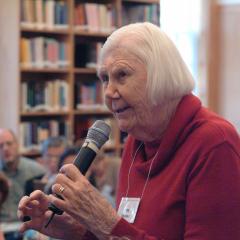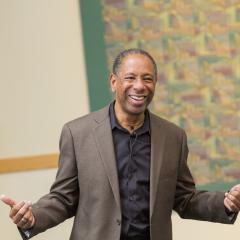Paul Joseph on Peace Cultures and "Real Cultures"
Paul Joseph delivered this keynote address at the February 5th session of the Center’s 1999 Cultures of Peace Conference. Dr. Joseph is Emeritus Professor of Sociology at Tufts University and was director of its Peace and Justice Studies Department at the time of this lecture.
Paul Joseph Keynote
I’m going to talk a little bit about the title of my talk, “Peace Cultures and Real or Operating Cultures.” Where does a peace culture fit if we look at the United States at the end of the 1990s, the beginning of the new millennium? I think we all would recognize that there’s a goal, that we’re trying to achieve the elements or the characteristics of a peace culture, but the achievement of this goal is pretty far in the future. Optimistically, though, some very important embryonic elements of a peace culture in the United States do exist, especially focused on the problem of war. But these elements, what I call implicit elements of the peace culture, coexist with the continuation of violence, enemy images, and many characteristics of a war culture that we know all too well. I’m very interested in the way those two pieces interact at the moment and how this interaction affects the potential for social movements, political debate, discussion, and alternatives over the near-, medium-, and long-term future?
Tension between war and peace characteristics are alive and present and very strong within the United States. For example, I believe that the Vietnam Syndrome, the idea that it’s very difficult for the public to accept sending troops overseas, may not be as strong as it was in the early seventies, but it is still alive and well in American culture today. But this syndrome appears in the midst of a whole series of tensions and contradictions that are important to explore.
The ways the Bush and Clinton administrations have tried to approach the public to legitimate their war policies reveal how much more difficult it is to gain public support for a war within the United States. For example, there was a tip-toeing up to war that occurred in the Gulf War, before the Bush administration went ahead. This also occurred recently in the way the Clinton administration first thought about and then finally used military force in the Gulf. You can see from these examples that there has to be a coaxing through the media to make sure latent images of war are not presented to the public. War, interestingly, has become not only an event where Americans can’t die, but where it’s difficult for other people to die as well, not only civilians but even, in a funny way, the other side’s military – unless it’s the part that’s completely identified with evil, with the enemy, with the other side.
The United States government, in its last efforts at going to war, has taken great pains to try to say that it’s not a war against people. The way in which it presents the war says a lot about what the public reaction is. Now the government is in the midst of a series of contradictions. Warrior myth is alive and well. The idea the United States needs to remain number one is also alive and well in American culture. Yet there is also the idea that there are fewer things worth fighting for. The legitimation process of Korea or the Vietnam War, when they were used in recent efforts, fell flat on its face. War can’t be fought for democracy in the same way. War can’t be fought, or presented as being fought, for oil. In fact, that may be the case, but the public process or perception can’t appear in the same way as in the past. Current factors create some real-life opportunities.
So I’d like us to think about the way in which there are elements about the United States public now and our popular culture that weigh significantly against the ease in which war was secured compared to the past. I also want us to explore the relationship between the full-bodied form of peace cultures outlined in its ideal state and the way in which we live in a popular culture in the United States now. It’s important to recognize the influence and inertia that materialism, consumer life, and the comparative comfort in which we live have on the development of a peace culture.
I’d also like to focus on the way in which individualism resonates so powerfully within our culture. Elise Boulding spoke of a very interesting image, about the two human needs, for bonding and for space. But the balance between these needs changes from one culture to the next. Ours is one with a stronger need for space relative to bonding than many other cultures and it’s very, very difficult to change that kind of bedrock. It affects the way we think about peace culture characteristics in the long run as well. For example, many of these ideal elements of peace are right, they’re important. But most people – I see this in my teaching – find it scary and challenging to live that way. These ideals call on us to be comfortable with profound and fundamental change. They’re taxing. We could probably agree that they’re taxing in a good way, but it’s different than the way in which most people live.
Think about risk or think about adventure, and oftentimes, maybe too often, we go in the other direction. Or think about what’s involved in making a commitment with others. There’s a tremendous reward, as most of us recognize, in that kind of activity. I found it myself just working on the Hiroshima/Nagasaki exhibit that Winston Langley mentioned before. How different it is to work on a project with others than it is to go off by yourself and write something, how both difficult and rewarding that can be. But this peace culture calls for a change and change can be seen as scary. The idea of change has been something that’s been manipulated as a threat and used by conservative movements in the United States for years in a constant pattern.
Just briefly, some implications and questions come out of this discussion. One is the concept of zones of peace or islands of peace. We know that there are arms controls treaties that have created zones of peace. There are cities that have created nuclear-free zones. There have been various declarations by municipalities in regard to important elements of war and peace. Another way to think about zones of peace is to step away from their physical and geographical elements and think about the interplay between war and peace cultures, or pieces of war and peace cultures that exist within ourselves. The zone of peace, or the contest between different zones of peace and war, exist within our hearts and our minds to some degree. I’m just thinking generally of us as metaphors, as representatives, more broadly, of life in the United States.
I mentioned also the important element of national characteristics, the importance of individualism. There are some elements about peace culture that will resonate strongly for people and there are some elements that might not find as ready an acceptance in the United States as they might in some other cultures. For example, the words “tranquility of the mind” or “trying to achieve harmony.” Maybe it’s just a projection on my part, but those phrases are not particularly strong, personal goals for me. To achieve tranquility of the mind. I get suspicious of that phrase. I get very nervous. So I’ll project this on Americans. But I can imagine harmony and tranquility of the mind resonating more in the popular culture of other parts of the world. When I walk down the street or when I think about my lived culture for the day or what’s going to happen, I know harmony is not going to be there and it’s not necessarily a state that I want to seek, except when I’m sleeping.
Another question I think is important is the progress and movement in different cultural spheres and fields. There’s been significant movement about the Vietnam Syndrome and the way in which it’s more difficult to achieve legitimation for war or to identify war with a project of national honor. Another example is the remarkable way in which World War II movies have changed over the last 10 or 15 years. They’ve been changed from the great war, the good fight, to a much more problematic presentation of who the Germans are, who the Japanese are, the way in which people are scared, the way the war seems more inconclusive. While I don’t think it’s a perfect movie, “Thin Red Line” is a remarkable statement about how even the good war, World War II, is being presented differently by Hollywood. However, I’ll also quickly note that we have no shortage of Sylvester Stallone, Arnold Swartznegger, and Jean Claude Van Damme images as well, perpetuating another dynamic of violence and the warrior, which is alive and well.
What is the source of movements? Leadership, social movements, circumstances, and situations. I would argue there is significant potential towards using the embryonic forms of peace culture that exist in our societies to move significantly toward the top of the page. But it’s going to take some imagination and political leadership that we’re missing right now. And we need to look at the way in which peace cultures interact, not only with war culture, but with the popular culture of the United States.


